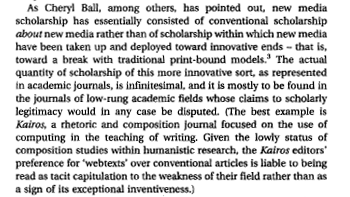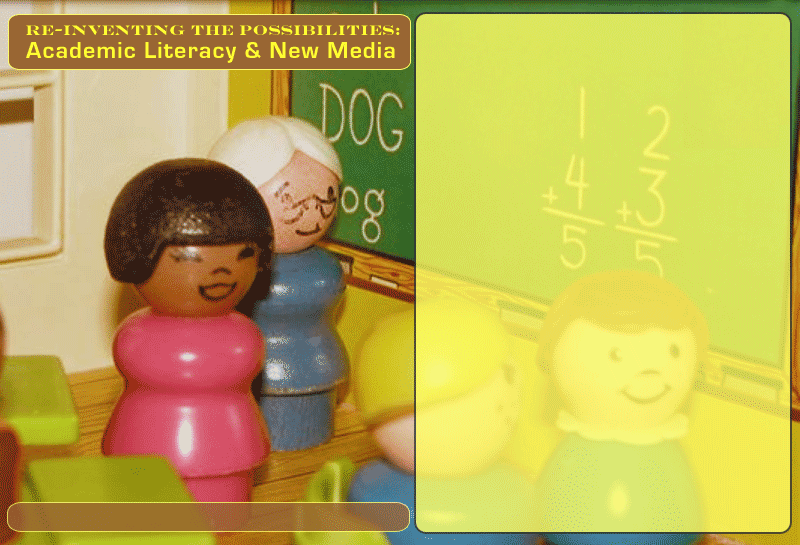Nevermind the barrage of the Internet and all of the global inundations of new media that students regularly have to interpret...after all, academics don't like to admit things like the Internet exist. (No, not you, dear audience. We know you love the Internet. We are talking about those other academics.) Instead, let's bring in some evidence of new media's encroach that writing studies cannot ignore much longer.
Online journals, like this one, are making inroads in demonstrating the importance of being digitally multiliterate. I take that term, digitally multiliterate, from a collection that Adrian Miles co-authored and edited in 2003 and which appeared in the online journal, Kairos. In his text, Miles adeptly argues that being able to analyze and compose multimodal texts in digital environments is crucial to being literate in the 21st century. Not, he quips, learning how to read Shakespeare or porting the linearity of academic, argumentative prose into webbed formats. In fact, his text, 'Digital Multiliteracies,' which is one section of the larger 'online academic publishing exercise' of the six-part collection Violence of Text, resembles neither traditional academic publishing nor an "exercise" because the collection is a highly sophisticated, scholarly new media text.
This is important to our discussion because, along with a literal handful of other that-which-new-media-literacy-should-resemble texts (see, e.g., Anderson, 2003; Cushman, 2004; Wysocki, 2002), Miles' collection is the best instantiation of performing its argument for new media in new media. That is, it is new media scholarship that uses the affordances of media and materials (through design) to persuade readers in new scholarly ways. Miles' text is one of the great examples of how new media can persuade, although not in the same ways that print-based, traditional, linear, often-uninspiring academically letterate texts do. Thank goodness.
But, sadly, there are few other examples as fulfilling as his—at least not in the limited supply of online composition journals, which, admittedly, is a field mostly populated by U.S. scholars. Compositionist Joyce Walker (2006) discusses why we don't see more texts like Miles' in her webtext, 'Hyper.activity', suggesting two reasons: (a) New media texts are difficult to compose because they take more time and knowledge than a traditional, academic argument does, and (b) Readers (which I interpret to mean hesitant authors, editors/reviewers, and journal audiences) don't yet understand how to make scholarly meaning from multimodal design elements. That is, Walker argues, we're still trying to map the persuasive evidence of linear traditions onto nonlinear, nontraditional texts. It just can't happen that way, she claims (2006), because new media texts make meaning in different ways than linear, written texts do. While online journals suggest (or even encourage) authors to publish designed texts (like Fibreculture does), authors don't or won't take advantage of branching out into nonwritten modes of communication.
The thing is, if writing studies have already moved towards theorizing about new media (see, e.g., Ball, 2004; Rice and Ball, 2006; Gossett, Walker, Lamanna, Squier, 2003; Sorapure, 2004, 2006; Walker, 2006; Warner, 2007; Wysocki, 2001; Wysocki, Johnson-Eilola, Sirc, and Selfe, 2004), and there are even a few examples of using new media to demonstrate (and, thus, legitimize) that scholarship (despite the naysayers), then why not bring that practice into the writing classroom itself? The reasons are mostly unexplored, although one might hypothesize that they rely on issues of what might be left out of the classroom should new media be brought in. To that, I would like to offer this quote:
And please, let's not try to start our institutional displacement by worrying about what our colleagues across the campus want a first-year writing course to do: if we have to answer to them for teaching students an intensified awareness of language, then they have to answer to us for the ecocide, economic immiseration, racial and gender insensitivity, and corporate ethics-lessness of their professions. (Sirc, 2001: p. 284)
Geoffrey Sirc, after all, is the king of thumbing his nose at "the" academic literacies taught in writing classes while still achieving the goals of first-year-writing classes. (Those goals we will discuss momentarily.) Although, to differentiate this webtext from his inspiring argument, we introduce digitality as part of producing multimodal and new media texts. Sirc, on the other hand, discusses students' production of static, analog Duchampian collages (2001) and, later, literal boxes/collections of materials to signify a whole-ishness of critical thought, a la Benjamin's arcades (Sirc, 2004). He rightly focuses on pleasure and learning--which is important to us as well, and our having learned that from Sirc is evidenced in our writing style in this text--but here we focus on how that-which-new-media-studies-will-become can contribute to general-education writing instruction via digital media.
---------------------------------------
On authors not composing new media...
In a survey of U.S. writing teacher-scholars who practice new media composition in their writing classrooms,
63 percent of respondents cited time issues—either time to learn new technologies (n=4) or time to implement that knowledge (n=6)—as preventing factors in producing their own digital media scholarship (q114). That is not a surprising factor considering that for those respondents who had already published multimodal scholarship (n=16), 31 percent (n=5) reported that it took them between 2– 5 months to compose a scholarly text and 19 percent (n=3) indicating that it took them more than a year to compose their multimodal text (q121). Overall, 44 percent of respondents for that question (q121) reported that it took them anywhere from “6–9 months” to “more than two years” to complete their multimodal scholarly text. (Anderson et al, 2006)
(Go back to the argument above)
My favorite, manifesto-ensuing-from-me quote (as this webtext partly enacts) was this nugget by James English (2005), given at the 2004 MLA conference to the Council of Editors of Learned Journals (prior to my having become editor of Kairos):

(Go back to the argument above)
On the unexplored reasons for not doing new media production in writing classes...
There are several authors who have tackled this topic in the last year or two, although the focus of these articles is nearly always on writing teachers who already implement new media production, not on those who might do it but haven't yet. For an overview of the troubles that writing teachers who ask students to produce new media texts face, see the already-important article, 'The When of New Media' by DeVoss, Cushman, and Grabill (2005), which details why infrastructural issues in computer labs can turn teachers away from new media production. In addition, Anderson et al. (2006) discuss the lack of technological resources for teachers who already do implement new media production into their classes, and so it's no wonder others don't pick up the call of new media literacy--it's expensive and requires a change in thinking about the political economies of English departments. (See Moeller, Cargile Cook, and Ball, forthcoming, for a discussion on how to enact technological change within a writing department by performing a political economy analysis.)
(Go back to the argument above)
Go back to the last node.
